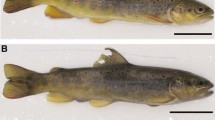Abstract
Juveniles of Leiognathus nuchalis were raised from fertilized eggs for up to 60 d and examined for luminescence activity. Almost all juveniles raised separately from adults failed to produce detectable light. In contrast, a significant percentage (33 to 100%) of the juveniles became luminescent in less than 48 h when they were either kept with adults or inoculated with a homogenate of the adult light organs. The luminescence tended to increase with time after the treatments. These findings suggest that: (1) most of L. nuchalis offspring typically hatch and develop apo-symbiotically and (2) at least 45 d after hatching, juveniles can be infected with symbiotic luminous bacteria from the light organ of adult fish, and thereby gain the ability to produce light.
Similar content being viewed by others
Author information
Authors and Affiliations
Additional information
Received: 16 February 1999 / Accepted: 21 September 1999
Rights and permissions
About this article
Cite this article
Wada, M., Azuma, N., Mizuno, N. et al. Transfer of symbiotic luminous bacteria from parental Leiognathus nuchalis to their offspring. Marine Biology 135, 683–687 (1999). https://doi.org/10.1007/s002270050669
Issue Date:
DOI: https://doi.org/10.1007/s002270050669




